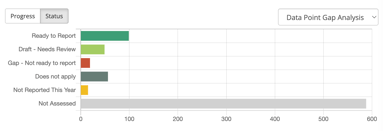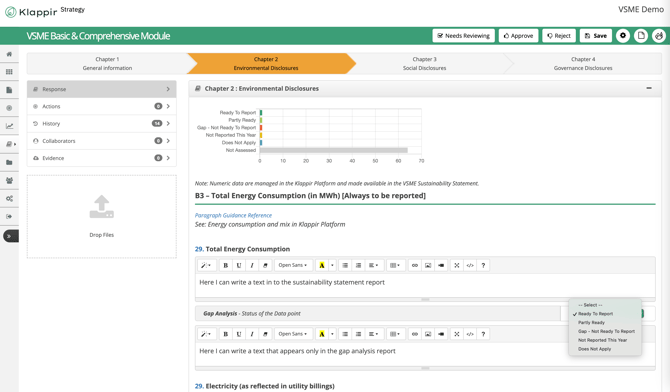5.2 Open the ESG Reporting Module
Manage data points and narrative disclosures for sustainability reporting.
What you’ll do in this step:
-
Navigate through your ESRS or VSME reporting template
-
Review chapters and disclosure data points
-
Begin tracking the status of each data point
-
Access and export the Gap Analysis for internal review
1. Navigate to the Reporting Module
From the Dashboard or left-hand menu, click on Reporting.
You’ll see the reporting framework that was set up for your organisation (usually done by Klappir during onboarding).
📌 Note: Reporting modules are tailored to your selected standard (e.g., VSME or ESRS).

2. Overview of the Reporting Structure
Each report is broken down into chapters - like for example ESRS S1 Own workforce:
1. Strategy
2. Policies
3. Processes
4. Actions
5. Targets
6. Metrics
You’ll also see a status overview at the top, showing:
-
Number of data points that need review

-
Status of each chapter
-
Latest updates and who made them
3. Open a Chapter
Click on any chapter (e.g. Chapter 1 – Strategy) to see the data points within.
Each data point corresponds to a specific disclosure requirement from ESRS or VSME. For example:
SBM-3 14 a – Description of types of employees and non-employees in its own workforce subject to material impacts
Each data point includes:
-
The exact wording of the disclosure requirement
-
Space to enter your disclosure narrative
- A dropdown for Gap Analysis – Status
- Space to enter comment to your Gap Analysis

4. Select the Status of Each Data Point
Use the Gap Analysis dropdown to indicate the status:
-
Not material – This does not apply to us
-
Gap - Not ready to report – We need to work on this
- Partly ready - Some data available, but incomplete or uncertain
-
Ready to report – We are confident in our disclosure
-
Not reported this year – Temporarily excluded from this year’s report
These statuses help you track reporting readiness and focus on priority gaps.
5. Generate Gap Analysis Overview
Once statuses are assigned, you can open the Gap Analysis Report to view a structured summary of your reporting readiness.
It includes:
-
Each paragraph and data point
-
The status you selected
-
Two fields:
-
Narrative for the Sustainability Statement
-
Internal notes that appear only in the Gap Analysis Report
-

Example:
| Paragraph | Sustainability Narrative | Gap Analysis Status | Internal Gap Note |
|---|---|---|---|
| B3.29 | "See energy mix in Klappir Platform" | Ready to Report | Full data available in Platform |
| B3.29.2 | "Self-generated electricity" | Gap – Not Ready | No data from solar meter |
| B3.30 | "Gross Scope 1 Emissions in tCO₂e, GHG Protocol" | Does Not Apply | No direct combustion sources |
Go to the next step: